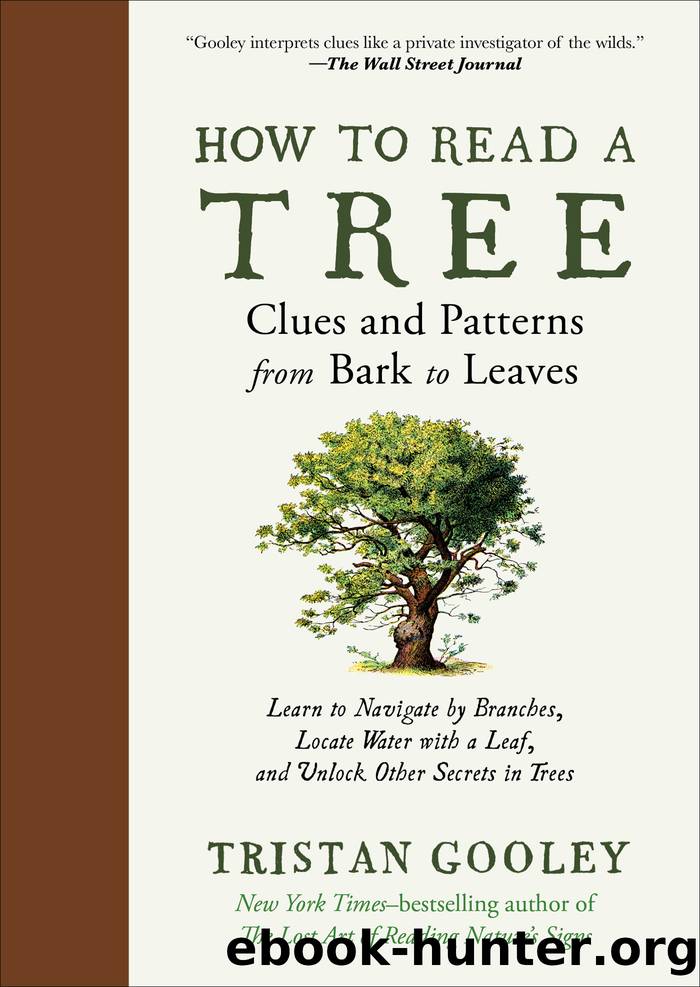How to Read a Tree by Tristan Gooley

Author:Tristan Gooley
Language: eng
Format: epub
ISBN: 9781615199440
Publisher: The Experiment
Published: 2023-05-15T00:00:00+00:00
Yellowing
As autumn approaches, trees draw chlorophyll from their leaves back into themselves: They dare not waste such a valuable resource. The popular colors we see in the leaves at this time of year, the yellows, oranges, and browns, are the colors of the leaves minus chlorophyll.
Sometimes you will see leaves that have turned yellow long before autumn. They are crying out for nourishment. The yellowing, known formally as âchlorosis,â is a sign that the tree is lacking in one or more of the key nutrients, like nitrogen or magnesium. It is rare in the wild and commoner when humans ask too much of a tree in poor soil, especially in urban areas or when weâve been busy upending a wilderness.
The yellow color is interesting because it is a negative effect: We see yellow, but we are actually looking at an absence of green. Chlorosis is a sign that the tree lacks the ingredients it needs to make chlorophyll. This is worth knowing as it helps make sense of other leaf-color puzzles. Instead of wondering what created a yellow or orange color, we can often unravel the mystery faster by asking ourselves, where has the green gone and why?
Water, pH levels, and disturbance all have an impact on leaf colors. We will see color changes in any landscapes that range from damp low country to higher, drier areas or from pristine wilderness to busy woods. This is why we will always see the colors fluctuate within the same species as we look down on a forest from a height.
There are times when spikes in the acidity in the soil will paint the leaves strongly. Acidic soil is low in nutrients and no landscape has uniform pH levels. I try to spot this when Iâm looking down from mountainsides in areas where there is mining, as this always leads to major fluctuations in water, disturbance, and pH levels. It is usually possible to spot the ripples in colors near the greatest activity.
On the flip side, some trees, especially conifers like Norway spruce, are happier in acidic soils and these trees will lose some of the rich green color in their foliage if the soil is too alkaline. Rivers and roads change water levels and soil chemistry, so it is rare for foliage to hold the same hue all the way to its edges.
There are always a few variables, so the simplest way to think about it is that a uniform rich green color in trees is a sign that the key influences are in the range they can tolerate happily. If we see a patch of trees with an âoffâ color, it is a sign that one of these variables is nudging danger levels for that species. If we have ticked off water and disturbance as likely causes, problems with the soil chemistry are worth considering.
Download
This site does not store any files on its server. We only index and link to content provided by other sites. Please contact the content providers to delete copyright contents if any and email us, we'll remove relevant links or contents immediately.
Sapiens: A Brief History of Humankind by Yuval Noah Harari(13988)
The Tidewater Tales by John Barth(12391)
Mastermind: How to Think Like Sherlock Holmes by Maria Konnikova(6936)
Do No Harm Stories of Life, Death and Brain Surgery by Henry Marsh(6686)
The Thirst by Nesbo Jo(6437)
Why We Sleep: Unlocking the Power of Sleep and Dreams by Matthew Walker(6352)
Life 3.0: Being Human in the Age of Artificial Intelligence by Tegmark Max(5184)
Sapiens by Yuval Noah Harari(5122)
The Longevity Diet by Valter Longo(4857)
The Body: A Guide for Occupants by Bill Bryson(4583)
The Rules Do Not Apply by Ariel Levy(4523)
The Immortal Life of Henrietta Lacks by Rebecca Skloot(4257)
Why We Sleep by Matthew Walker(4190)
Animal Frequency by Melissa Alvarez(4150)
Yoga Anatomy by Kaminoff Leslie(4100)
The Hacking of the American Mind by Robert H. Lustig(4085)
All Creatures Great and Small by James Herriot(3986)
Barron's AP Biology by Goldberg M.S. Deborah T(3944)
Double Down (Diary of a Wimpy Kid Book 11) by Jeff Kinney(3925)
